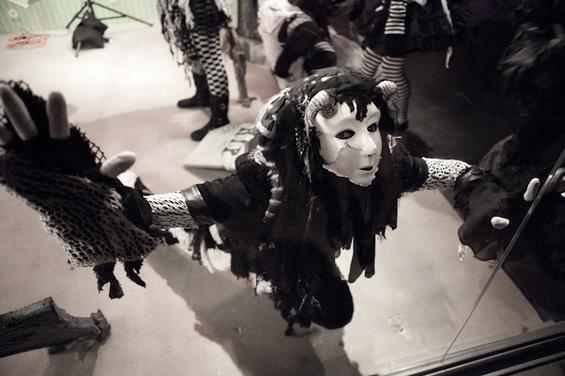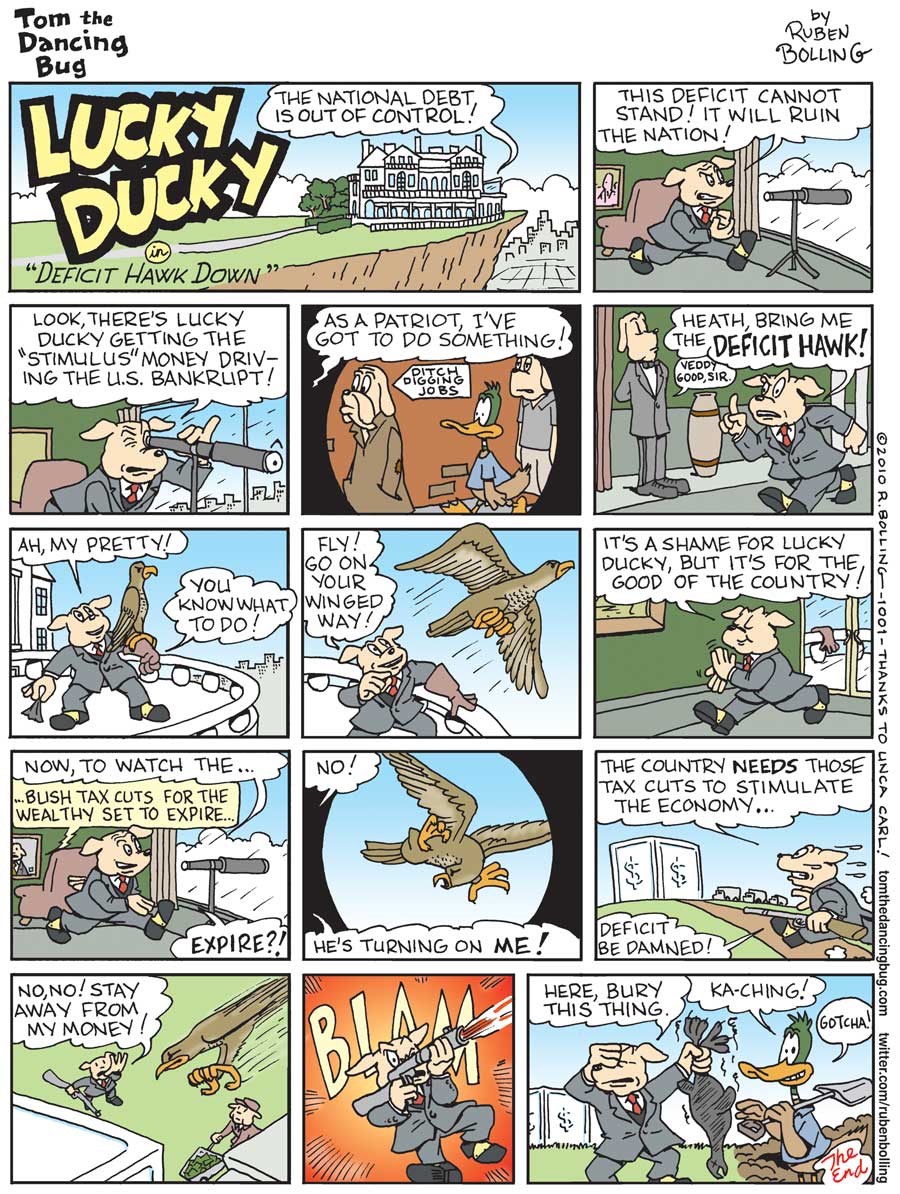The Latest from Boing Boing |  |
- NSFW tribute to Ray Bradbury
- Hitchcock vs. The Birds (spoiler: the birds win)
- The Wandering Marionettes' Gorgeous Masked Performances
- Gabrielle Bell's comic strip about ComicCon
- My favorite museum in Japan: The Takayama Showa Kan
- The 90th anniversary of the 19th amendment in Mississippi will be in 2074
- Bus-on-stilts from China is awesome, not widely useful
- Tom the Dancing Bug: Deficit Hawk Down
- The very hungry (and carnivorous) caterpillar
- The Fuggetabuddies
- A lifetime supply of doll arms on the auction block
- Coin-operated park bench in China?
- Otyp nears Kickstarter goal to make DNA thermal cylclers for high schoolers
- Science cookie cutters
- Dr. Laura: criticism of me infringes my first amendment rights
| Posted: 18 Aug 2010 04:40 PM PDT Rachel Bloom from Upright Citizens Brigade has a not-safe-for-work ode to the greatest sci-fi writer in history. Makes me want to do an answer song about Philip K. Dick.
F* Me, Ray Bradbury |
| Hitchcock vs. The Birds (spoiler: the birds win) Posted: 18 Aug 2010 04:24 PM PDT |
| The Wandering Marionettes' Gorgeous Masked Performances Posted: 18 Aug 2010 04:13 PM PDT  Photo: Shannon Cottrell/LA Weekly from "Hello Kitty's Bats and Cats Masquerade @ Royal/T" The Wandering Marionettes are a performance troupe based in Los Angeles who have become an important part of the city's nightlife. They appear frequently at clubs and other events (like Labyrinth of Jareth) across L.A. dressed in black and white and wearing sleek masks, using music and dance to tell a story of mysterious dolls. I wrote about The Wandering Marionettes when they put together their own party, Kabinet Theatre, in Hollywood last year. (They've hosted Kabinet Theatre nights since then, as well, but moved it downtown.) I like The Wandering Marionettes for a reason similar to The League of S.T.E.A.M.: both emphasize audience interaction in their work. Typically, The Wandering Marionettes will do a few dance numbers on stage, but that's only part of what they do. The members of the troupe are in character all night and much of their performance revolves around their interaction with the crowd. They might be on the dance floor or hanging around the bar with everyone else, but they don't speak and how you react to them more or less prompts what happens next. Check out the video below to see The Wandering Marionettes on stage. Link: The Wandering Marionettes Photo: Shannon Cottrell/LA Weekly from "Hello Kitty's Bats and Cats Masquerade @ Royal/T" The Wandering Marionettes are a performance troupe based in Los Angeles who have become an important part of the city's nightlife. They appear frequently at clubs and other events (like Labyrinth of Jareth) across L.A. dressed in black and white and wearing sleek masks, using music and dance to tell a story of mysterious dolls. I wrote about The Wandering Marionettes when they put together their own party, Kabinet Theatre, in Hollywood last year. (They've hosted Kabinet Theatre nights since then, as well, but moved it downtown.) I like The Wandering Marionettes for a reason similar to The League of S.T.E.A.M.: both emphasize audience interaction in their work. Typically, The Wandering Marionettes will do a few dance numbers on stage, but that's only part of what they do. The members of the troupe are in character all night and much of their performance revolves around their interaction with the crowd. They might be on the dance floor or hanging around the bar with everyone else, but they don't speak and how you react to them more or less prompts what happens next. Check out the video below to see The Wandering Marionettes on stage. Link: The Wandering Marionettes |
| Gabrielle Bell's comic strip about ComicCon Posted: 18 Aug 2010 03:12 PM PDT |
| My favorite museum in Japan: The Takayama Showa Kan Posted: 18 Aug 2010 03:54 PM PDT  (In July, I went on a family vacation to Japan. Here are my posts about the trip: The Ghibli Museum | Watermelons in the shape of cubes, hearts, and pyramids | What happened to the Burgie Beer UFO of Melrose Avenue? | Shopping in Harajuku | A visit to Iwatayama Monkey Park in Kyoto Japan | Nara Deer Park near Kyoto.) I felt like I was in a giant thrift store bursting with Japanese products from the the mid 20th century. No guards were stationed in the many rooms crammed with household goods, educational equipment, tools, and other cultural artifacts. No items, as far as I could tell, were nailed down. This place would be a shoplifter's paradise (and a liability insurance abuser's motherlode) in the United States, but we were in Japan, where they don't seem to worry as much about that kind of thing. The place is called the Showa Kan (Showa refers to the time period, 1926-1989, and Kan means hall). It's a privately run museum in Takayama, a beautiful city in the Chūbu region of central Japan. My wife, two daughters, and I spent a couple of pleasant hours wandering through the rooms here, which were decorated like businesses and institutions from the period. There was a doctor's office, a classroom, an appliance store, a bicycle repair shop, a living room, a bedroom, a barber shop, and so on. Many more photos and remarks after the jump. (You can click any photo to embiggen it.)
[L]iving organisms, including people, are merely tubes which put things in at one end and let them out at the other, which both keeps them doing it and in the long run wears them out. So to keep the farce going, the tubes find ways of making new tubes, which also put things in at one end and let them out at the other. At the input end they even develop ganglia of nerves called brains, with eyes and ears, so that they can more easily scrounge around for things to swallow. As and when they get enough to eat, they use up their surplus energy by wiggling in complicated patterns, making all sorts of noises by blowing air in and out of the input hole, and gathering together in groups to fight with other groups. In time, the tubes grow such an abundance of attached appliances that they are hardly recognizable as mere tubes, and they manage to do this in a staggering variety of forms. There is a vague rule not to eat tubes of your own form, but in general there is serious competition as to who is going to be the top type of tube. All this seems marvelously futile, and yet, when you begin to think about it, it begins to be more marvelous than futile. Indeed, it seems extremely odd. Truer words were never spoken!
|
| The 90th anniversary of the 19th amendment in Mississippi will be in 2074 Posted: 18 Aug 2010 04:23 PM PDT Today is the 90th anniversary of the 19th Amendment to the U.S. Constitution—which granted women the right to vote and be just as disappointed in their choices at the ballot box as men. Delightfully, while most of the states ratified the amendment in 1919 and 1920, 10 states either initially rejected the measure, or simply put it off altogether. (Federal law trumped, so women could still vote in the 10 holdout states, even before they got around to ratification.) Delaware, Maryland, Virginia and Alabama had all ratified by the mid 1950s. Florida signed on in 1969. The Carolinas, Georgia and Louisiana all agreed that women should be able to vote during the 1970s. Mississippi held out until 1984. (Via hectocotyli) |
| Bus-on-stilts from China is awesome, not widely useful Posted: 18 Aug 2010 01:10 PM PDT You take the low road—I'll take the 1200-person bus on stilts. Pros: Basic concept—raised passenger compartment that allows "bus" to use regular roads while cars travel beneath it—seems like a fun solution for getting to the faster-than-a-traffic-jam speeds of dedicated rail without, you know, the cost of dedicated rails. Cons: Trying to imagine a city in the United States that simultaneously has the density to need a 1200-person bus and the height clearance to allow something this tall to travel freely about town. Even if you scaled it down to a smaller passenger size, I don't see this fitting under freeway overpasses or even beneath the electrical lines that hover over wide avenues. |
| Tom the Dancing Bug: Deficit Hawk Down Posted: 18 Aug 2010 11:30 AM PDT |
| The very hungry (and carnivorous) caterpillar Posted: 18 Aug 2010 11:01 AM PDT At first, you might think the weirdest thing about this little caterpillar is its body—long and skinny, with a patch of legs at the front and a patch at the back, it does a lot of rearing up and strategically falling onto things. That last bit becomes important later. See, this little Hawaiian caterpillar is a killer. The Carnivorous Caterpillar is a product of island evolution, which is, itself, a pretty weird phenomenon. For instance, a study published in PLoS Biology in October of 2006 found that mammal populations on islands can change their physical appearance and structure at a rate as much as 3.1 times greater than that of mainland mammals. Islands breed both unusual caterpillars and fast-evolving mammals thanks to a combination of isolated populations—through which mutations can more easily spread—fierce competition for limited resources, and the odd interactions that happen between species of plants and animals that are all experiencing the same sort of pressures. After all, the ecological niche—what you eat, where you live, who eats you—a species inhabited on the mainland might not exist the same way on an island. And it's likely to change relatively rapidly, along with resources and the spread of useful mutations. Over hundreds or thousands of years, an island species can come to look and act very differently from its mainland cousins. This video is part of Life Is—A new website that brings together tons of clips from BBC nature documentaries and arranges them in a procrastination-friendly browsing menu. You can search for videos by climate, geography, even predominant color scheme—so a passing fancy for a carnivorous caterpillar could lead you to pig-nosed turtles, Chinese rice fields and whistling rats. |
| Posted: 18 Aug 2010 10:33 AM PDT The Fuggetabuddies are Jon Benjamin and Jon Glaser. Jesse Thorn says, "When it comes to comedy pieces that are barely anything, this is by far my favorite. I can watch this over and over and laugh every time. Fuggetaboutit." Not safe for work. |
| A lifetime supply of doll arms on the auction block Posted: 18 Aug 2010 10:13 AM PDT  On eBay: "Big lot of 630 antique german bisque doll arms." High bid is just $5.50 (but shipping is $39). More photos of similar auctions at Anonymous Works. |
| Coin-operated park bench in China? Posted: 18 Aug 2010 10:37 AM PDT PAY & SIT: the private bench (HD) from Fabian Brunsing on Vimeo. In 2008 artist Fabian Brunsing made a coin-operated park bench. When you insert a 0.50 Euro coin, spikes in the bench's seat retract, allowing you to sit. This story from Orange News claims that officials at Yantai Park in Shangdong province, eastern China, have installed similar benches in the park. I doubt it. The photo in the article is of Brunsing's bench. Do any of our readers from China know if this story is true or not? |
| Otyp nears Kickstarter goal to make DNA thermal cylclers for high schoolers Posted: 18 Aug 2010 04:15 PM PDT When I was at Maker Faire Detroit last month, I met the guys from Otyp, and was very impressed by them and their work. They've created an open source thermal cycler, called the Thermotyp, along with a number of biotech projects for high schoolers. At Make Faire, they were showing people how to use the Thermotyp to clone jellyfish DNA and spell out "Hello World!" in fluorescent DNA in a petri dish. Otyp is trying to raise a total of $10,000 to distribute their thermal cyclers and project kits to high schools. Through Kickstarter, they've already received about $7,500. They have five days to go before the campaign closes!
"Hello, World!" - Modern Biotechnology for High Schools, a Kickstarter for Otyp |
| Posted: 18 Aug 2010 08:35 AM PDT  I've posted in the past about biological anthropologist-turned-geeky Martha Stewart Not So Humble Pie—especially the magical way she has with science-themed baked goods. Now there's a quick way for less-ambitious cooks to capture a teeny bit of the Not So Humble ambiance—a set of four science cookie cutters, featuring beaker, flask, test tube and atom shapes. In the picture above, you can see the results, as decorated by Ms. Humble (though she's not the one selling them). Bonus for Oklahomans (and how often does that happen?): If you live in the OKC area you can arrange pick-up on these cookie cutters and save yourself some shipping costs. (Thanks to Sophia C.—my favorite Belgian—for pointing this out!) |
| Dr. Laura: criticism of me infringes my first amendment rights Posted: 18 Aug 2010 03:43 PM PDT  Dr. Laura Schlessinger is leaving radio to regain her "first amendment" rights on the internet. Welcome to the blogosphere, Dr. Laura! This follows her on-air use of the N-word to suggest that it shouldn't always be taken as a slur. Dr. Laura Schlessinger is leaving radio to regain her "first amendment" rights on the internet. Welcome to the blogosphere, Dr. Laura! This follows her on-air use of the N-word to suggest that it shouldn't always be taken as a slur.It's not clear exactly who Schlessinger claims took her free speech away, though she suggests special interest groups are silencing her by pressuring sponsors. Without the ability to earn a living, she said, "I don't have the right to say what I need to say. My first amendment rights have been usurped." Schlessinger's announcement -- and her invocation of a constitutional right to earn a living from her speech -- was made on Larry King Live. In it, King and Schlessinger both indulged the idea that the issue is about whether its OK for black people to use the N-word but not OK for whites. "I thought I was trying to be helpful," she told King. "I thought I was making a philosophical point." Laura believes her use of the term illustrates an important point about semantics: that its offensiveness is rooted in context and history, and that we'll be happier if we look beyond our reactive sensitivitities to better understand our interlocutors' motives. But that "philosphical" point was never really the problem. Context does matter, and the context here was a caller suffering from daily encounters with racial discrimination in her family life. Schlessinger denied the reality of her caller's problem so she could veer off into a rant about political correctness and language. Laura's not quitting because her constitutional rights are under threat, but because she said the N-Word eleven times in an act of childish transgressive spite and can't take the heat. People get the criticism of our racial double-standards, but also get that she used that as a specious excuse to turn a caller's personal problems into an inane tirade about something else entirely. In watching the Larry King Live segment [Gawker TV], however, the most striking thing is how eager Schlessinger is to play the hapless, helpless victim herself. For someone in the business of giving life advice, bathos is clearly the new black. |
| You are subscribed to email updates from Boing Boing To stop receiving these emails, you may unsubscribe now. | Email delivery powered by Google |
| Google Inc., 20 West Kinzie, Chicago IL USA 60610 | |































































No comments:
Post a Comment